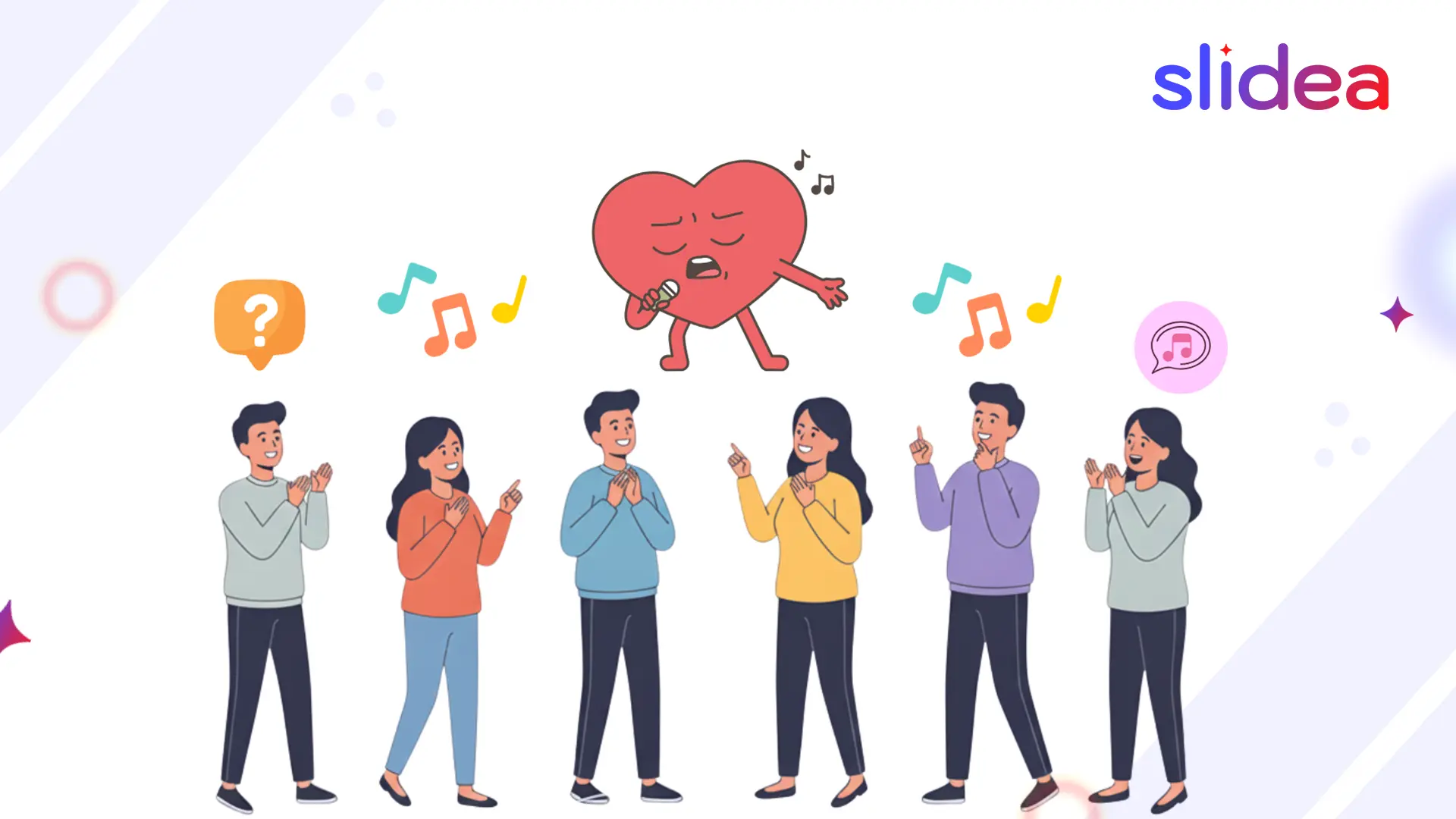Think outside the box. That’s what lateral thinking puzzles are all about; they challenge your creativity, logic, and reasoning skills in ways straightforward questions can’t.
And guess what? Whether you’re hosting a virtual event, leading a classroom quiz, or running a hybrid team session, these brain teasers are the perfect icebreaker.
Even better? You can make it more fun using live polls, word clouds, and fun quizzes that spark engagement across virtual meetings and hybrid events.
Ready to twist your brain? Let’s dive into 35 mind-bending puzzles with answers!
What Are Lateral Thinking Puzzles?
Lateral thinking puzzles are questions or scenarios where the solution isn’t obvious, you’ll need creative, indirect thinking to crack the code. They’re designed to:
- Encourage critical thinking
- Improve problem-solving
- Build team collaboration
- Make learning and training fun!
They’re great for classrooms, team building, leadership training, or get-together with friends. And when used with interactive presentation tools, they’re even more engaging.
Lateral vs. Vertical Thinking
Before you dive into the puzzles, let’s know how lateral thinking works and how it differs from traditional “vertical” thinking. Here’s a simple comparison to get you in the right mindset:
| Aspect | Lateral Thinking | Vertical Thinking |
| Approach | Looks for indirect, creative, or non-obvious solutions | Follows logical, step-by-step methods |
| Focus | Explores multiple possibilities or ideas | Narrows down to one best solution |
| Goal | Encourages out-of-the-box thinking | Aims for accuracy and efficiency |
| Problem-solving style | Jumps between ideas and perspectives | Moves in a linear, structured path |
| Best for | Puzzles, brainstorming, innovation, and creative challenges | Math, technical analysis, and fact-based decisions |
| Thinking direction | Sideways or unconstrained | Upward and deeper within a single thought track |
| Risk level | Open to trying new or even absurd ideas | Risk-averse; prefers proven methods |
| Common in | Design, advertising, storytelling, team-building activities | Science, law, accounting, engineering |
35 Fun & Challenging Lateral Thinking Puzzles with Answers
These brain teasers are perfect for teens, adults, classrooms, and even virtual meetings. Use them in live polls, quizzes, or word clouds to boost engagement.
Easy Starters (Great for Teens)
Perfect warm-ups to get those brains ticking!
1. The Man in the Elevator
Puzzle: A man lives on the 10th floor. Every day he takes the elevator to the ground floor, but when he returns, he only goes to the 7th and walks up. Why?
Answer: He’s short and can’t reach the 10th-floor button.
2. The Bottle and the Coin
Puzzle: How can you drop a coin into a bottle without touching or breaking it?
Answer: Push the cork in and drop the coin through the neck.
3. The Dead Man in the Desert
Puzzle: A man is found dead in the desert with a backpack. What happened?
Answer: His parachute didn’t open.
4. The Stolen Ring
Puzzle: A woman says her ring was stolen. The maid claims she didn’t open any drawers. The police arrest her. Why?
Answer: How did the maid know the ring was in a drawer?
5. The Light Switches
Puzzle: Outside a room are 3 switches. One controls a bulb inside. You can enter only once. How do you know which switch controls it?
Answer: Turn one switch on for a while, then turn it off. Turn another on and enter. The lit bulb = 2nd switch; warm bulb = 1st.
Moderate Puzzles (Best for Group Activities)
Perfect for classroom teams, online polls, or hybrid learning games.
6. The Two Doors
Puzzle: You are standing in front of two doors. One leads to safety, the other to certain danger. Each door is guarded by a person. One always tells the truth, the other always lies. You don’t know which is which, and you can only ask one question to one guard to figure out the safe door. What question should you ask?
Answer: If I asked the other guard which door leads to safety, what would he say?
Then, choose the opposite door.
7. The Murder in the Locked Room
Puzzle: A man is found dead inside a completely locked room. There are no signs of forced entry, no weapons, and the only odd thing in the room is a puddle of water near the body. How did he die?
Answer: He was stabbed with an icicle, which later melted, leaving only the puddle behind.
8. The Blindfolded Rope
Puzzle: You have two ropes that burn in one hour but unevenly. How do you time 45 minutes?
Answer: Burn one at both ends and the other at one end. When the first finishes (30 min), light the second from the other end.
9. The Man in the Bar
Puzzle: A man asks for water. The bartender pulls a gun. The man says thanks and leaves. Why?
Answer: He had hiccups. The scare cured them.
10. The Poisoned Wine
Puzzle: Two people drink the same poisoned wine. One dies, the other lives. Why?
Answer: The poison was in the ice; it melted slowly in the first drink.
11. The Broken Clock
Puzzle: A man sets his clock at night but wakes up late. The clock hasn’t moved. Why?
Answer: The clock’s battery died after he set it.
12. The Unopened Package
Puzzle: A man is found dead next to a sealed package. No injuries. How did he die?
Answer: The unopened package was a parachute that failed to deploy.
13. The Silent Classroom
Puzzle: A teacher enters a noisy class and says one word. Everyone quiets down. What did she say?
Answer: “Test.”
14. The Locked Car
Puzzle: A man locks his car with the windows open. A stranger reaches in and steals nothing. Why?
Answer: The top was down, it’s a convertible.
15. The Cold Room
Puzzle: A man is found dead in a freezing room with no heat. The window is shut, and the door is locked. How did he die?
Answer: He died of hypothermia, no foul play involved.
16. The Library Murder
Puzzle: A man is found dead in a library. There are no weapons or signs of struggle. The only clue is a book in his hand, open to a page with a red circle around one word: “silence.” What happened?
Answer: He was trying to signal his killer, the librarian before dying. “Silence” hinted at the quietest person in the room.
17. The Coffee Cups
Puzzle: Five cups of coffee are poisoned, but one man survives. How?
Answer: He drank his coffee quickly. The poison was in the sugar, which hadn’t dissolved yet.
18. The Birthday Puzzle
Puzzle: A girl was born in December but her birthday is always in summer. How?
Answer: She lives in the Southern Hemisphere.
19. The Blue Room
Puzzle: A man walks into a blue room with no windows and sees something red. What is it?
Answer: His own blood, he got injured.
20. The Odd One Out
Puzzle: Which is the odd one: Cow, Dog, Cat, Sheep?
Answer: Dog, it doesn’t produce milk.
Difficult Brain Twisters (Adults Will Love These!)
Challenge your team, class, or friends with these tricky ones.
21. The Alphabet Sequence
Puzzle: What comes next? O, T, T, F, F, S, S, ?
Answer: E (Eight. It’s the first letter of numbers.)
22. The Manhole Cover
Puzzle: Why are manhole covers round?
Answer: So they don’t fall into the hole.
23. The Boat Puzzle
Puzzle: A man must get a fox, chicken, and grain across a river. Only one fits in the boat.
Answer: Take chicken. Return. Take grain, bring chicken back. Take fox. Return. Take chicken.
24. The Misdirection Dollar
Puzzle: 3 friends pay $30. They’re refunded $5. They each get $1. $2 is left. Where’s the missing dollar?
Answer: There’s no missing dollar, it’s a misdirection.
25. The Silent Town
Puzzle: A man drives into town. It’s packed, but no one is around. Why?
Answer: Everyone’s at church.
26. The Whispering Voices
Puzzle: A man hears voices at night. No one else is in the house. What’s happening?
Answer: He left his Bluetooth headset on, it’s receiving a call.
27. The Empty Safe
Puzzle: A robber breaks into a safe but finds it empty. Why?
Answer: It was a decoy. The real valuables were hidden elsewhere.
28. The Disappearing Chair
Puzzle: A man sits on a chair. It disappears but he doesn’t fall. How?
Answer: It was a wheelchair, he stood up and walked away.
29. The Burnt Letter
Puzzle: A man burns a letter after reading it. Why?
Answer: It was secret information, he was a spy.
30. The Unopened Gift
Puzzle: A child cries over a gift but hasn’t opened it yet. Why?
Answer: They were expecting something else and felt disappointed.
31. The Reverse Countdown
Puzzle: A bomb is set to explode in 10 minutes. The timer increases instead of decreasing. Why?
Answer: It’s counting up to delay panic. The actual time is hidden.
32. The Sleeping Guard
Puzzle: A guard sleeps through his shift but is rewarded. Why?
Answer: He was undercover pretending to be drunk.
33. The Train Puzzle
Puzzle: A man stands on a track. A train rushes at him, but he’s fine. Why?
Answer: He’s on a parallel track.
34. The Black Suitcase
Puzzle: A man picks up a black suitcase and panics. Why?
Answer: It’s not his, he picked up someone else’s identical case at the airport.
35. The Fire Escape
Puzzle: A man jumps from a burning building and survives. No safety net. How?
Answer: He jumped out the ground-floor window.
How Slidea Makes Lateral Thinking Puzzles Even More Fun
Lateral thinking puzzles are already brainy and fun, but with Slidea, they become fully interactive experiences that boost energy, laughs, and engagement. Here’s how you can level up your session using Slidea’s powerful tools:
- Live Polls – Let everyone guess before they reveal and enjoy those “aha!” moments together
- Interactive Quizzes – Turn puzzles into scoring games for classroom fun or team-building
- Word Clouds – Gather guesses in real time and visualize your group’s thinking
- Ranking Slides – Let the crowd vote for the best or funniest solutions
Final Thoughts
Lateral thinking puzzles aren’t just fun, they build smarter, more engaged minds. Whether you’re teaching teens or training a remote team, they break the ice, spark curiosity, and keep everyone thinking.
With interactive presentation software, you can turn ordinary questions into unforgettable, interactive learning moments.
FAQs
Q1. What is a lateral thinking puzzle?
It’s a puzzle that requires creative, non-linear thinking to solve, not just logic.
Q2. Who can solve lateral thinking puzzles?
They’re fun for teens, adults, teachers, and teams, basically anyone who enjoys a challenge.
Q3. Can I use these puzzles in online classes?
Absolutely! They’re perfect for virtual learning with Slidea’s interactive features.
Q4. How do I make puzzles interactive?
Use tools like live polls, quizzes, and word clouds to let your audience participate in real time.
Q5. Are these puzzles good for team building?
Yes! They spark collaboration and out-of-the-box thinking during meetings or training sessions.




Leave a Comment
Your email address will not be published. Required fields are marked *